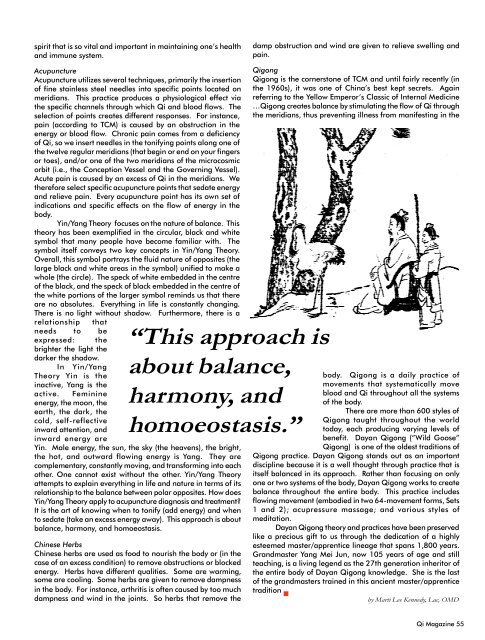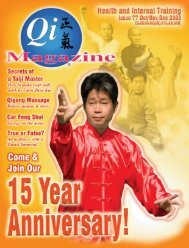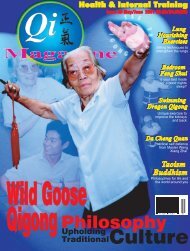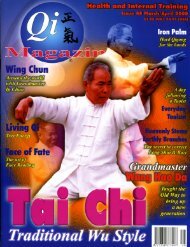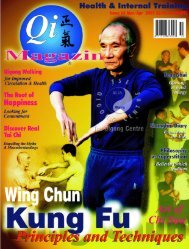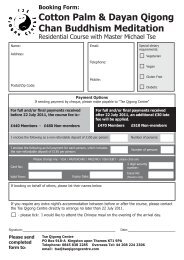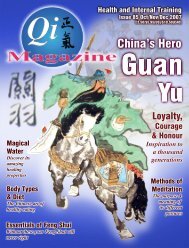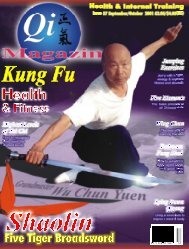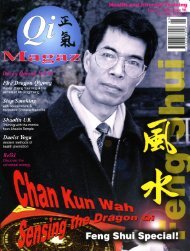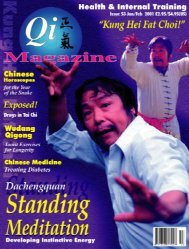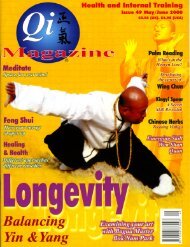Create successful ePaper yourself
Turn your PDF publications into a flip-book with our unique Google optimized e-Paper software.
spirit that is so vital and important in maintaining one’s healthand immune system.damp obstruction and wind are given to relieve swelling andpain.AcupunctureAcupuncture utilizes several techniques, primarily the insertionof fine stainless steel needles into specific points located onmeridians. This practice produces a physiological effect viathe specific channels through which Qi and blood flows. Theselection of points creates different responses. For instance,pain (according to TCM) is caused by an obstruction in theenergy or blood flow. Chronic pain comes from a deficiencyof Qi, so we insert needles in the tonifying points along one ofthe twelve regular meridians (that begin or end on your fingersor toes), and/or one of the two meridians of the microcosmicorbit (i.e., the Conception Vessel and the Governing Vessel).Acute pain is caused by an excess of Qi in the meridians. Wetherefore select specific acupuncture points that sedate energyand relieve pain. Every acupuncture point has its own set ofindications and specific effects on the flow of energy in thebody.Yin/Yang Theory focuses on the nature of balance. Thistheory has been exemplified in the circular, black and whitesymbol that many people have become familiar with. Thesymbol itself conveys two key concepts in Yin/Yang Theory.Overall, this symbol portrays the fluid nature of opposites (thelarge black and white areas in the symbol) unified to make awhole (the circle). The speck of white embedded in the centreof the black, and the speck of black embedded in the centre ofthe white portions of the larger symbol reminds us that thereare no absolutes. Everything in life is constantly changing.There is no light without shadow. Furthermore, there is arelationship thatneeds to beexpressed: the“This approach isabout balance,harmony, andhomoeostasis.”brighter the light thedarker the shadow.In Yin/YangTheory Yin is theinactive, Yang is theactive. Feminineenergy, the moon, theearth, the dark, thecold, self-reflectiveinward attention, andinward energy areYin. Male energy, the sun, the sky (the heavens), the bright,the hot, and outward flowing energy is Yang. They arecomplementary, constantly moving, and transforming into eachother. One cannot exist without the other. Yin/Yang Theoryattempts to explain everything in life and nature in terms of itsrelationship to the balance between polar opposites. How doesYin/Yang Theory apply to acupuncture diagnosis and treatment?It is the art of knowing when to tonify (add energy) and whento sedate (take an excess energy away). This approach is aboutbalance, harmony, and homoeostasis.Chinese HerbsChinese herbs are used as food to nourish the body or (in thecase of an excess condition) to remove obstructions or blockedenergy. Herbs have different qualities. Some are warming,some are cooling. Some herbs are given to remove dampnessin the body. For instance, arthritis is often caused by too muchdampness and wind in the joints. So herbs that remove the<strong>Qigong</strong><strong>Qigong</strong> is the cornerstone of TCM and until fairly recently (inthe 1960s), it was one of China’s best kept secrets. Againreferring to the Yellow Emperor’s Classic of Internal Medicine…<strong>Qigong</strong> creates balance by stimulating the flow of Qi throughthe meridians, thus preventing illness from manifesting in thebody. <strong>Qigong</strong> is a daily practice ofmovements that systematically moveblood and Qi throughout all the systemsof the body.There are more than 600 styles of<strong>Qigong</strong> taught throughout the worldtoday, each producing varying levels ofbenefit. Dayan <strong>Qigong</strong> (“Wild Goose”<strong>Qigong</strong>) is one of the oldest traditions of<strong>Qigong</strong> practice. Dayan <strong>Qigong</strong> stands out as an importantdiscipline because it is a well thought through practice that isitself balanced in its approach. Rather than focusing on onlyone or two systems of the body, Dayan <strong>Qigong</strong> works to createbalance throughout the entire body. This practice includesflowing movement (embodied in two 64-movement forms, Sets1 and 2); acupressure massage; and various styles ofmeditation.Dayan <strong>Qigong</strong> theory and practices have been preservedlike a precious gift to us through the dedication of a highlyesteemed master/apprentice lineage that spans 1,800 years.Grandmaster Yang Mei Jun, now 105 years of age and stillteaching, is a living legend as the 27th generation inheritor ofthe entire body of Dayan <strong>Qigong</strong> knowledge. She is the lastof the grandmasters trained in this ancient master/apprenticetraditionby Marti Lee Kennedy, Lac, OMDQi Magazine 55


